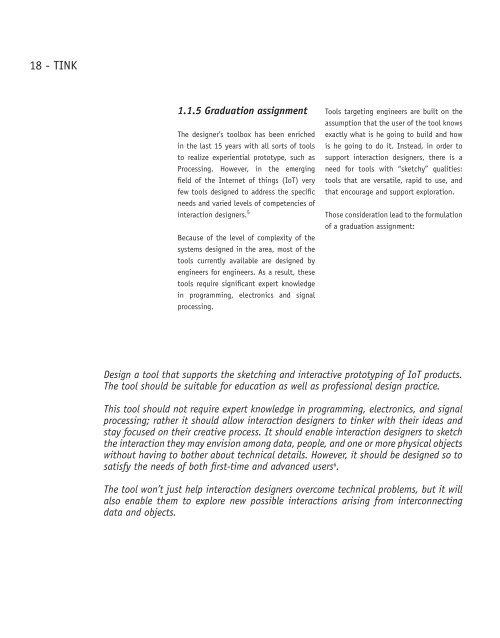TINK - sketching product experiences of connected objects
Tink is the result of my graduation project from the master in design for interaction at TUDelft. Tink is a web platform that connects products with one another via the Internet, it provides designers with a complete Internet of Things (IOT) development environment. Designers are provided with a rich stack of features to sketch, prototype and test IOT projects. Tink is a user-friendly, visual, collaborative, open-source tool for designers to build connected interactions among objects.
Tink is the result of my graduation project from the master in design for interaction at TUDelft.
Tink is a web platform that connects products with one another via the Internet, it provides designers with a complete Internet of Things (IOT) development environment.
Designers are provided with a rich stack of features to sketch, prototype and test IOT projects. Tink is a user-friendly, visual, collaborative, open-source tool for designers to build connected interactions among objects.
Create successful ePaper yourself
Turn your PDF publications into a flip-book with our unique Google optimized e-Paper software.
18 - <strong>TINK</strong><br />
1.1.5 Graduation assignment<br />
The designer’s toolbox has been enriched<br />
in the last 15 years with all sorts <strong>of</strong> tools<br />
to realize experiential prototype, such as<br />
Processing. However, in the emerging<br />
field <strong>of</strong> the Internet <strong>of</strong> things (IoT) very<br />
few tools designed to address the specific<br />
needs and varied levels <strong>of</strong> competencies <strong>of</strong><br />
interaction designers. 5<br />
Because <strong>of</strong> the level <strong>of</strong> complexity <strong>of</strong> the<br />
systems designed in the area, most <strong>of</strong> the<br />
tools currently available are designed by<br />
engineers for engineers. As a result, these<br />
tools require significant expert knowledge<br />
in programming, electronics and signal<br />
processing.<br />
Tools targeting engineers are built on the<br />
assumption that the user <strong>of</strong> the tool knows<br />
exactly what is he going to build and how<br />
is he going to do it. Instead, in order to<br />
support interaction designers, there is a<br />
need for tools with “sketchy” qualities:<br />
tools that are versatile, rapid to use, and<br />
that encourage and support exploration.<br />
Those consideration lead to the formulation<br />
<strong>of</strong> a graduation assignment:<br />
Design a tool that supports the <strong>sketching</strong> and interactive prototyping <strong>of</strong> IoT <strong>product</strong>s.<br />
The tool should be suitable for education as well as pr<strong>of</strong>essional design practice.<br />
This tool should not require expert knowledge in programming, electronics, and signal<br />
processing; rather it should allow interaction designers to tinker with their ideas and<br />
stay focused on their creative process. It should enable interaction designers to sketch<br />
the interaction they may envision among data, people, and one or more physical <strong>objects</strong><br />
without having to bother about technical details. However, it should be designed so to<br />
satisfy the needs <strong>of</strong> both first-time and advanced users 6 .<br />
The tool won’t just help interaction designers overcome technical problems, but it will<br />
also enable them to explore new possible interactions arising from interconnecting<br />
data and <strong>objects</strong>.


